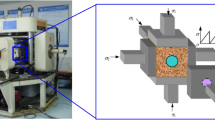Abstract
A relevant parameter for estimating discontinuity shear strength is the basic friction angle, usually derived from different types of tilt tests. However, the tilt tests described in the literature produce varying basic friction angle values. From a large number of different types of tilt tests on different kinds of rocks, it was possible to conclude that the mechanisms of sliding along cylinder generatrixes and planar surfaces are quite different, and that tests based on sliding along generatrixes are not appropriate for determining reliable basic friction angle values for discontinuity planes. Tests on small specimens are also not recommended, for geometry reasons and because ensuring reliable stress conditions is difficult. To quantify the natural variability in tilt testing, large specimens of the same granite were tested. The results revealed coefficients of variation for the basic friction angle in the range of 5–10 %, a variability which is no greater than that found for other rock mechanics parameters. This observation enables to forward some recommendations concerning the appropriate number of tests needed to obtain reliable results.












Similar content being viewed by others
References
Alejano LR, Taboada J, Bastante FG, Rodríguez P (2008) Multi-approach back-analysis of a roof collapse in a mining room excavated in stratified rock. Int J Rock Mech Min Sci 45:899–913. doi:10.1016/j.ijrmms.2007.10.001
Alejano LR, Gómez-Márquez I, Martínez-Alegría R (2010) Analysis of a complex toppling-circular slope failure. Eng Geol 114:93–104. doi:10.1016/j.enggeo.2010.03.005
Alejano LR, Ferrero AM, Ramírez-Oyanguren P, Álvarez-Fernández MI (2011) Comparison of limit equilibrium, numerical, and physical models of wall slope stability. Int J Rock Mech Min Sci 48:16–26. doi:10.1016/j.ijrmms.2010.06.013
Barton N (1971) Estimation of in situ shear strength from back analysis of failed rock slopes. Rock fracture. Proc Int Symp Rock Mech 2:27
Barton N (1973) Review of a new shear-strength criterion for rock joints. Eng Geol 7:287–332
Barton N (1976) The shear strength of rock and rock joints. Int J Rock Mech Min Sci Geomech Abstr 13:255–279. doi:10.1016/0148-9062(76)90003-6
Barton N, Bandis S (1982) Effects of block size on the shear behaviour of jointed rock mass. In: 23rd US Symposium on Rock Mech. Berkeley, CA, pp 739–760
Barton N, Choubey V (1977) The shear strength of rock joints in theory and practice. Rock Mech 10:1–54. doi:10.1007/BF01261801
Bruce IG, Cruden DM, Eaton TM (1989) Use of a tilting table to determine the basic friction angle of hard rock samples. Can Geotech J 26:474–479
Coulson JH (1972) Shear strength of flat surfaces in rock stability of rock slopes. In: Cording EJ (ed) Proceedings of 13th Symposium on Rock Mechanics, American Society of Civil Engineers, New York, pp 77–105
Cruden DM, Hu XQ (1988) Basic friction angles of carbonate rocks from Kananaskis country, Canada. Bull Int Assoc Eng Geol 38:55–59. doi:10.1007/BF02590448
Hoek E, Bray J (1974) Rock slope engineering. Institution of Mining and Metallurgy, London
Horn HM, Deere DU (1962) Frictional characteristics of minerals. Géotechnique 12:319–335. doi:10.1680/geot.1962.12.4.319
Hutchinson JN (1972) Field and laboratory studies of a fall in Upper Chalk cliffs at Joss Bay, Isle of Thanet. In: Parry RHG (ed) Proceedings of the Roscoe Memorial Symposium, University of Cambridge. G.T. Foulis & Co, Yeovil, pp 692–706
Krsmanović D (1967) Initial and residual shear strength of hard rocks. Géotechnique 17:145–160. doi:10.1680/geot.1967.17.2.145
Muralha J (1995) Probabilistic approach of the mechanical behaviour of rock discontinuities (in Portuguese). PhD thesis, Instituto Superior Técnico, Lisbon
Patton FD (1966) Multiple modes of shear failure in rock. In: Proceedings of 1st Congress of the International Society for Rock Mechanics (I), Lisbon, pp 509–513
Richards LR (1975) The shear strength of joints in weathered rock. University of London, Disseration
Ripley CF, Lee KL (1962) Sliding friction tests on sedimentary rock specimens. In: 7th International Congress of Large Dams (IV), Rome, pp 657–671
Sagaseta C (1986) On the modes of instability of a rigid block on an inclined plane. Rock Mech Rock Eng 19:261–266. doi:10.1007/BF01039998
Stimpson B (1981) A suggested technique for determining the basic friction angle of rock surfaces using core. Int J Rock Mech Min Sci Geomech Abstr 18:63–65
Ulusay R, Hudson JA (2007) The Complete ISRM suggested methods for rock characterization, testing and monitoring: 1974–2006. ISRM Turkish Natl Group, Ankara
Wallace GB, Slebir EJ, Anderson FA (1970) Foundation testing for Auburn Dam. In: Somerton WH (ed) Rock mechanics: theory and practice. Soc Min Eng Am Inst Min Metall Pet Eng, New York, pp 461–498
Acknowledgments
The authors acknowledge the Autonomous Government of Galicia (Consellería de Innovación e Industria de la Xunta de Galicia) for funding the research project INCITE08PXIB304076PR, which funded some developments in this paper. Thanks to Ailish M.J. Maher for providing assistance with English usage.
Author information
Authors and Affiliations
Corresponding author
Rights and permissions
About this article
Cite this article
Alejano, L.R., González, J. & Muralha, J. Comparison of Different Techniques of Tilt Testing and Basic Friction Angle Variability Assessment. Rock Mech Rock Eng 45, 1023–1035 (2012). https://doi.org/10.1007/s00603-012-0265-7
Received:
Accepted:
Published:
Issue Date:
DOI: https://doi.org/10.1007/s00603-012-0265-7




